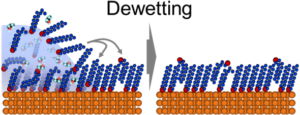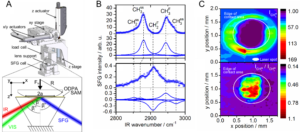Christian Meltzer
Dr.-Ing. Christian Meltzer
Project description
Former project: In situ spectroscopy of Selforganization, drying, aging and manipulation of molecular monolayers on aluminum oxide
Project area: NA
Supervisor: Prof. Dr.-Ing. Wolfgang Peukert
Influencing surface properties is a key challenge in a wide range of technologies. In research, self-assembled molecular monolayers (SAMs) show a huge potential ranging from their use in organic field effect transistors [1], to friction reduction [2] and increase in corrosion resistance [3]. Nevertheless, SAMs are so far not widely used in industrial applications. Reasons for this are long processing times to create SAMs and a low reproducibility of SAM properties. Therefore we study the self-assembly mechanisms of Octadecylphosphonic acid (ODPA) on α-Al2O3 (0001) with sum-frequency spectroscopy. This measurement method allows us to study SAM formation in situ and provides information on SAM coverage and order.
Based on our experiments we discovered three phases of the formation of an ODPA SAM on the studied substrate. At first the solvent (2-propanol) covering the substrate after the SAM solution is brought in contact with the surface is replaced by ODPA molecules. In this phase the ODPA molecules are completely disordered. In a second phase a surface coverage sufficient to build-up SAM order is reached, and the additional adsorption of ODPA molecules results in ordered domains. After even longer times, almost all solvent is replaced. From this stage onwards, the order of the layer is further increased, although this process is much slower and takes several hours.
We discovered, that at the end of the assembly, there is still a significant amount of defects present in the SAM. This is strongly reduced during drying, based on a Quasi-Langmuir-Blodgett-Transfer taking place during drying (see Figure 1). [4]
In addition, we study SAMs under mechanical pressure (see Figure 2). Here we discovered, that defects are generated in the layers studied with SFG, which is well in-line with MD simulations, performed at the CCC of the University of Erlangen-Nürnberg. Furthermore we also studied the lateral extend of the contact area. A comparison to the theoretical size of the contact area, based on Hertzian contact theory, showed good agreement of theory and experiment. [5]

Fig. 1: Schematic illustration of the Quasi-Langmuir-Blodgett-Transfer. For details of the experimental results see [4]

Fig. 2: (A) schematic of the experimental setup used to study ODPA SAMs on α-Al2O3 (0001) under mechanical compression. (B) SFG spectra of the SAM before mechanical compression (upper part) and under a pressure of 171 MPa (lower part). Changes in the spectrum clearly indicate the formation of defects. (C) results of the 2D scan of the contact area. For further details see [5].
References
[1] T. Schmaltz, et al., Adv. Mat. 25 (2013) 4511.
[2] J. Paul, et al., Langmuir 32 (2016) 8298.
[3] M. Frank et al., Applied Surface Science 404 (2017) 326
[4] C. Meltzer, et al., Langmuir 31 (2015) 4678.
[5] C. Meltzer et al., J. Am. Chem. Soc. 136 (2014) 10718.

